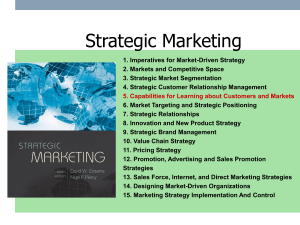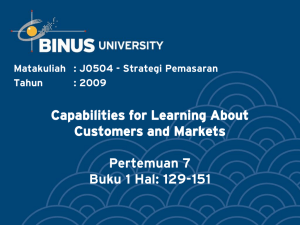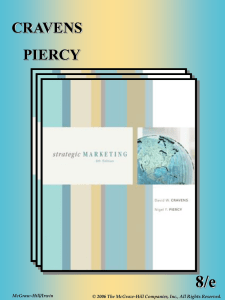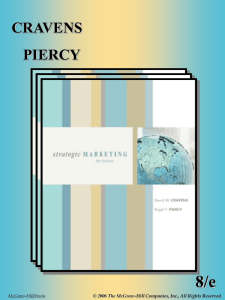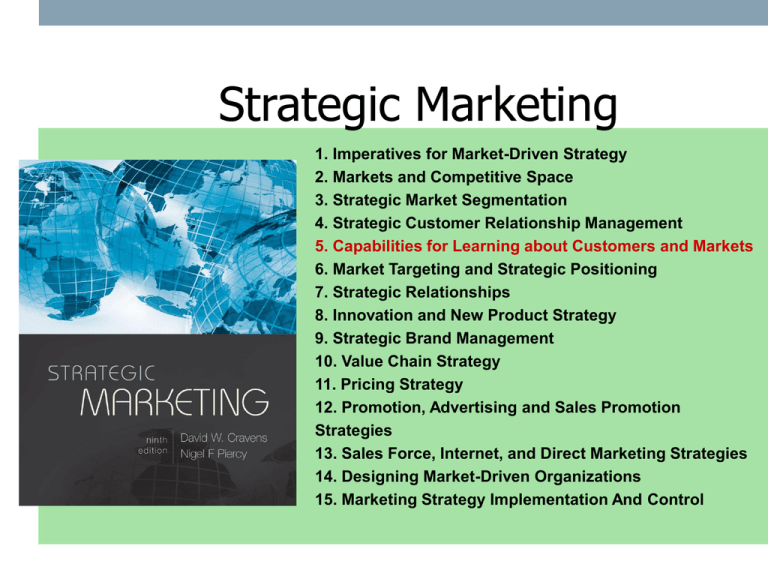
Strategic Marketing
1. Imperatives for Market-Driven Strategy
2. Markets and Competitive Space
3. Strategic Market Segmentation
4. Strategic Customer Relationship Management
5. Capabilities for Learning about Customers and Markets
6. Market Targeting and Strategic Positioning
7. Strategic Relationships
8. Innovation and New Product Strategy
9. Strategic Brand Management
10. Value Chain Strategy
11. Pricing Strategy
12. Promotion, Advertising and Sales Promotion
Strategies
13. Sales Force, Internet, and Direct Marketing Strategies
14. Designing Market-Driven Organizations
15. Marketing Strategy Implementation And Control
Chapter 5
Capabilities for Learning
About Customers and
Markets
McGraw-Hill/Irwin
Copyright © 2009 by The McGraw-Hill Companies, Inc. All rights reserved.
Capabilities for learning about customers and markets
* Market-driven strategy, market sensing and
learning processes
* Marketing information and knowledge resources
* Marketing intelligence and knowledge
management
* Ethical issues in collecting and using information
5-3
Learning capabilities at P&G
* Competitive strength from superior customer
knowledge
* To deliver a customer experience, less formal
research, more one-to-one communication
*
*
*
*
*
Consumer Village
Online virtual reality Cave
Watch people clean baths
Understand what it is like to live on $50/month
Social networking sites
5-4
Market Sensing and Learning Processes
* Market sensing processes
* Learning organization
* Learning and competitive advantage
* Learning about markets
* Barriers to market learning processes
5-5
Market sensing at Tesco International
* Retailer entry to U.S. grocery market, not
with existing format
* Discovering what U.S. consumers want:
* Senior managers live with U.S. families
* Probe lifestyles of families
* Prototype store
* Developing a new retail format and targeting
the “grocery gap”
5-6
Market sensing processes
*
*
*
*
*
*
Open-minded inquiry processes
Analyzing competitors’ actions
Listening to front-line employees
Searching for latent customer needs
Scanning the peripherary of the market
Encouraging experimentation
5-7
Marketing information and knowledge resources
* Scanning processes
* Specific marketing research studies
* Internal and external marketing information
resources
* Relationships with external marketing research
providers
5-8
Screening A New Research Supplier
1. Client Would you recommend this
supplier?
2. Supplier Do you have sufficient funds for
this project?
3. What parts of the project will be
subcontracted, and how do you manage
subcontractors?
4. May I see your interviewer’s manual and data
entry manual?
5. How do you train and supervise
interviewers?
5-9
Screening A New Research Supplier
6. What percentage of interviews are
validated?
7. May I see a typical questionnaire?
8. Who draws your samples?
9. What percentage of your data entry is
verified?
10. Managers - What do you think about
this supplier?
Source: Seymour Sudman and Edward Blair,
Marketing Research, A Problem-Solving Approach, Irwin/McGraw-Hill, 1998, 67.
5-10
A Framework for Market Sensing
Probability of the Event Occurring
High
Medium
Low
7
6
Effect of the
Event on the
Company
Field of
Dreams
Utopia
5
Things to
Watch
4
3
2
Danger
Future
Risks
1
* 1=Disaster, 2=Very bad, 3=Bad, 4=Neutral, 5=Good, 6=Very good, 7=Ideal
5-11
Learning About Markets
Objective
Inquiry
Keeping and
Gaining Access
to Prior
Learning
Synergistic
Information
Distribution
Mutually
Informed
Interpretations
Source: George S. Day, Journal of Marketing, October 1994.
5-12
Barriers to market learning
* Managers reject new
insights/information
* Rigid organizational structures and
inflexible information systems
* Politics favour the status quo
* Overwhelming pressure of existing
business operations
* Tendency to “active inertia”
5-13
Best Buy’s customer knowledge strategy
* Strategy treats customers as individual,
develops solutions for needs and engages
employees to serve them
* New ideas from listening more closely to
customers and employees
* Knowledge shared with manufacturers and
product developers
* Core innovation competency is gathering
and synthesizing customer intelligence
5-14
Customers and design at Xerox
* “Customer-led innovation” - “dreaming with
the customer”
* Not just building prototype and getting
feedback
* Focus groups as first step in commercial
printer design
* Changing designs in response to customer
insights
* Investment in understanding what
customers think about the “bright ideas”
5-15
Marketing research project
* Defining the problem
* Understanding the limitations of the
research
* Quality of the research
* Costs
* Evaluating and selecting suppliers
* Research methods
5-16
Existing marketing information resources
*
*
*
*
In-company resources
Open source resources
Research agency resources
5-17
Creating new marketing information
* Observation and ethnographic studies
* Marriott - rethink hotel experience for
“road warriors”
* GE - developing plastic fibers position
* Intel - use of computers by children in
China
* Research surveys
* Internet-based research
5-18
Problem definition to guide marketing research studies
Research
Project and Scope
Describe the topic
for the study and
the background.
Research
Objectives
Set specific goals for
the study - why is it
being undertaken?
Research
Questions
Planned
Outcomes
Identify the specific
pieces of information
required and the
questions that need
to be asked to obtain
that information
When completed how
should the results be
presented for management
use?
5-19
Impact of the Internet on Marketing Costs and Availability
* Online Surveys
* Fast
* Inexpensive
* Limitations in population coverage
* Resistance to excessive Web
communications
* Customer feedback and peer-to-peer Web
communications
* Monitoring customer Web behavior
5-20
Marketing and management information systems
* Marketing information systems
* Management information systems
* Marketing decision support systems
5-21
Marketing Decision-Support System Components
Database
Analysis
Capabilities
Display
Models
5-22
Marketing intelligence and knowledge management
*
*
*
*
Marketing intelligence
Knowledge management
Role of the chief knowledge officer
Leveraging customer knowledge
5-23
Ethical issues in collecting and using information
* Invasion of customer privacy
* Information and ethics
* Information collection
* Research subjects
* Information sharing
5-24
Neuromarketing
* Magnetic resonance imaging (MRI)
* Pictures response of brain to stimuli
* Probing consumer preferences is
controversial
* Invasive
* Privacy issues
* Information sharing
* Insurance companies
* Employers
* Law enforcement
5-25

